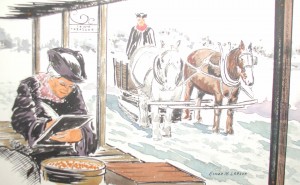The Hawleys are true blue Americans. Not only because of their great-great-grandfathers, who started right in, in the years 1607 and 1620 (ever memorable dates in our history) or thereabouts, to help this country grow up.
While we all of us might have been here just the same if this family of affairs had not come from overseas, can we, with any show of certainty, say that it would have been as well with us without them?
Joseph Hawley, in 1629 sought a home in Connecticut and settled at Stratford where he held many public offices. He was tax collector, and this was no sinecure, for taxes were paid in wheat, corn, peas, and the like, which the collector must store, sell or or deliver for shipment to distant markets. He was one of a committee to draft a patent which is still preserved, signed by Governor Treat. It was Governor Treat who was annually reelected for many successive years. At 86 years of age, he declined reelection and retired to private life.

Elizabeth, daughter of Joseph Hawley, colonist, was born in 1651. On June 7, 1670 she married Captain John Chapman. He was Captain of the train band and Deputy from Saybrook and from East Haddam for over 20 sessions. The Captain’s second wife was Elizabeth Beamont. Second wives and third husbands play important parts in family records in colonial days. That is, they seem to conspicuous by their presence. Everyone was good in those days, we are to suppose, and died young.
Samuel and Thomas Hawley were other New England “first ancestors”. The towns Hawleyville, Connectcut and Hawley, Massachusetts were this named in honor of the family and possibly Stratford was so called because Joseph Hawley, was of Stratford-upon-Avon branch of the Hawley family.
Westchester County, New York was the home of Thomas Hawley, who was born at Reading, Connecticut and was probably a descendant of Joseph Hawley, first ancestor.
 The statesman and soldier, General Joseph Roswell Hawley, was born in North Carolina in 1826. He was the son of Rev Francis Hawley, a native of Connecticut. He married in North Carolina a maiden of Scottish descent. While Joseph was still a boy his father returned to Connecticut, and in 1866 Joseph became Governor of the state. He was a firm believer in the American people and the “American way”. He was United States Senator during the latter years of his life.
The statesman and soldier, General Joseph Roswell Hawley, was born in North Carolina in 1826. He was the son of Rev Francis Hawley, a native of Connecticut. He married in North Carolina a maiden of Scottish descent. While Joseph was still a boy his father returned to Connecticut, and in 1866 Joseph became Governor of the state. He was a firm believer in the American people and the “American way”. He was United States Senator during the latter years of his life.
In 1881, General and Senator Joseph Hawley delivered the centennial address at Groton Heights, Connecticut, where in 1911 the Memorial Gateway was dedicated with its tablets of bronze, on which are inscribed the names of brave men, the heroes of a well fought fight. They gave their strength, many of them their lives, in defense of Groton and New London, September 6, 1781.
The military members of the family include Benjamin Hawley, aide to Lord Hill at Waterloo and Henry Hawley was second in command of cavalry at Fontenoy in 1745.
The coat of arms is: Vert, a saltire, or St Andrews cross, engrailed argent. Crest: A dexter arm in armor proper, garnished or holding in the hand a spear, in bend sinister point downward, also proper.
Motto: Suivez moi (Follow me).
Vert or green is not a common tincture in heraldry. It symbolizes loyalty, joy and peace, with the emerald for its precious stone and goddess Venus as its guardian.
The blazing by precious stones and the gods of mythology and even by the virtues, was a foolish fancy of heraldic writers of the sixteenth century, and was applied to the arms of peers and Princes, Gwillim, an heraldic writer of note, condescends to use it.
The saltire or saltier, or santoir is known as the cross of St Andrew , patron saint of Scotland. It symbolizes according to fanciful heraldic lore, resolution. An arm in armor means one fitted for performance of high enterprises. The spear was bestowed only upon a valiant soldier as is emblematic of knightly service and devotion to duty.
The crest of the Hawleys of County Hants, England is a winged thunderbolt. The founder of this branch of the family was Lord Francis Hawley, and one member of this family Robert Hawley, married a Susan, daughter of Lord Sayre and Sele, for whom Saybrook, Connecticut was named.
The Hawleys of Leybourne Grange, Kent, England use the arms previously described.
Excerpted from The Cincinnati Enquirer, 1927, by Frances M. Smith & Eleanor Lexington


